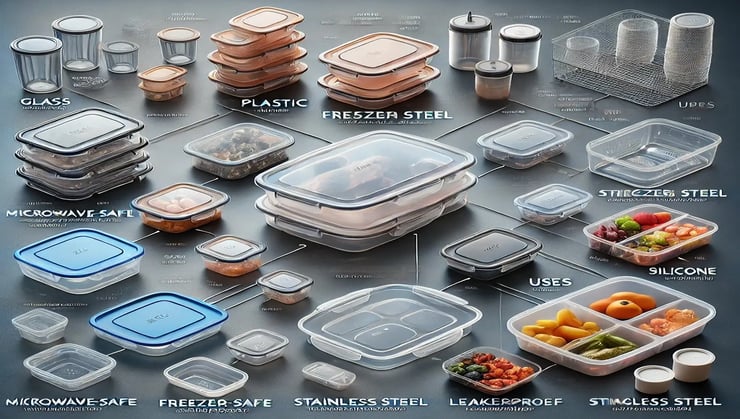
Smart Storage Solutions: Picking the Right Containers for Your Needs
Once you understand safe storage basics, focus on choosing the right containers. Lear-ning about different materials, sizes, and their specific uses helps you optimize storage conditions and maintain food integrity.
FOOD SAFETY AND STORAGE
Mae Ellison
2/26/20253 min read


Storage Container Selection: Materials, Sizes, and Uses
Selecting the right storage containers can transform your meal prep routine from a chore into an efficient system. Whether you’re prepping lunches for the week or planning meals for the entire family, the right containers help maintain freshness, control portions, and keep everything organized.
Below, we’ll explore key factors to consider when choosing storage containers, including materials, sizes, and best uses. By the end of this guide, you’ll know how to pick the best containers to fit seamlessly into your meal prep lifestyle.
Choosing the Right Material for Meal Prep Containers
Selecting the proper material ensures safety, longevity, and convenience. Here are three main types to consider:
Glass vs. Plastic vs. Stainless Steel
Glass Containers: Durable, odor-resistant, and able to handle both hot and cold temperatures. Suitable for reheating meals in ovens or microwaves.
Plastic Containers: Lightweight, affordable, and often labeled BPA-free. Ensure leakproof lids and durable construction to avoid warping or staining.
Stainless Steel: Eco-friendly and durable but typically not microwave-safe. Great for cold meals, salads, or snacks when you need a lightweight option.
BPA-Free and Food-Safe Labels
To minimize risks, choose plastic containers clearly marked “BPA-free” or “food-safe.” These certifications help ensure that your food won’t be exposed to harmful chemicals during storage or reheating. Glass containers are naturally BPA-free and often considered the safest option for long-term use.
Sustainability and Reusability
Glass and stainless steel containers can last for years if handled properly, reducing waste and the need for frequent replacements. If you prefer plastic, opt for high-quality brands that resist staining and warping to prolong their lifespan.
Different Sizes and Shapes for Meal Prep Efficiency
Choosing the right container shapes and sizes can make your meal prep routine more efficient and organized.
Portion Control Containers
If you want to manage calorie intake or balance macronutrients, portion control containers are a great choice. They typically include compartments or pre-measured sections for proteins, carbs, and veggies.
Stackable Storage Solutions
For those with limited fridge or pantry space, look for containers that nest or stack neatly. This design maximizes vertical space and keeps your kitchen clutter-free.
Ideal Sizes for Different Meals
Small (1–2 cups): Great for snacks, sauces, or dressings.
Medium (3–4 cups): Perfect for single-serving lunches or dinners.
Large (5+ cups): Ideal for batch cooking, family-style dishes, or storing soups and stews.
Best Meal Prep Containers for Different Uses
Your ideal container choice will depend on how you plan to store and serve your meals.
Microwave-Safe and Heat-Resistant Options
If you frequently reheat meals, glass is the best choice as it tolerates high heat without warping or absorbing odors. Certain plastic containers labeled “microwave-safe” also work, but always confirm their temperature limits to avoid damage.
Leakproof and Airtight Containers
Look for lids with tight seals or snap-lock mechanisms to prevent spills, especially if you’re transporting meals to work or school. Airtight lids also help keep meals fresh longer.
Freezer-Safe and Dishwasher-Safe Containers
For those who freeze meals, ensure your containers can withstand cold temperatures without cracking. Dishwasher-safe labels save time during cleanup, making meal prep even more convenient.
Top Brands and Products for Meal Prep Storage
When selecting containers, consider well-known brands that offer reliability and durability.
Popular Brands and Their Unique Features
Pyrex: Durable glass containers that are oven-safe.
Rubbermaid: Offers BPA-free plastic options with leakproof lids.
Tupperware: A classic brand with a wide range of sizes and shapes.
Glasslock: Specializes in shatter-resistant glass with secure locking lids.
Budget-Friendly vs. Premium Options
Budget-Friendly: Affordable plastic sets, ideal for beginners or short-term storage.
Premium: High-end glass or stainless steel containers that may cost more but typically last longer and offer more features (such as oven safety or advanced locking systems).
Where to Buy the Best Meal Prep Containers
You can find quality containers both online and in stores. To shop wisely, evaluate product reviews, compare prices, and check return policies. Some local kitchenware shops offer sales or discounts that can help you save on premium brands.
Tips for Maintaining and Organizing Meal Prep Containers
Proper care extends the lifespan of your containers and keeps them hygienic.
How to Properly Clean and Store Containers
Wash containers promptly with warm, soapy water (or use the dishwasher if safe) to prevent odors and stains. Dry thoroughly before stacking or nesting them to avoid mildew.
Labeling and Organizing for Easy Access
Use removable labels or dry-erase markers to note the contents and date. Group similar meals or ingredients together, and store older items in front to ensure they’re used first.
Extending the Lifespan of Your Containers
Avoid exposing plastic containers to extreme heat (like under a broiler). Check for signs of wear—such as cracks or warped lids—and replace as needed to keep your meal prep system safe and efficient.
Final Thoughts
By choosing the right materials, sizes, and features for your storage containers, your meal prep routine becomes simpler, fresher, and more organized. Whether you’re freezing large batches of soup, portioning out healthy lunches for the week, or simply stashing away snacks, investing in the right containers will help you maintain a consistent, budget-friendly, and hassle-free meal prep strategy.
Take the time to assess your cooking habits, kitchen space, and budget. Once you find the ideal containers, you’ll be surprised at how much easier it is to stick to your meal prep goals—and how much better your meals taste when stored properly.
